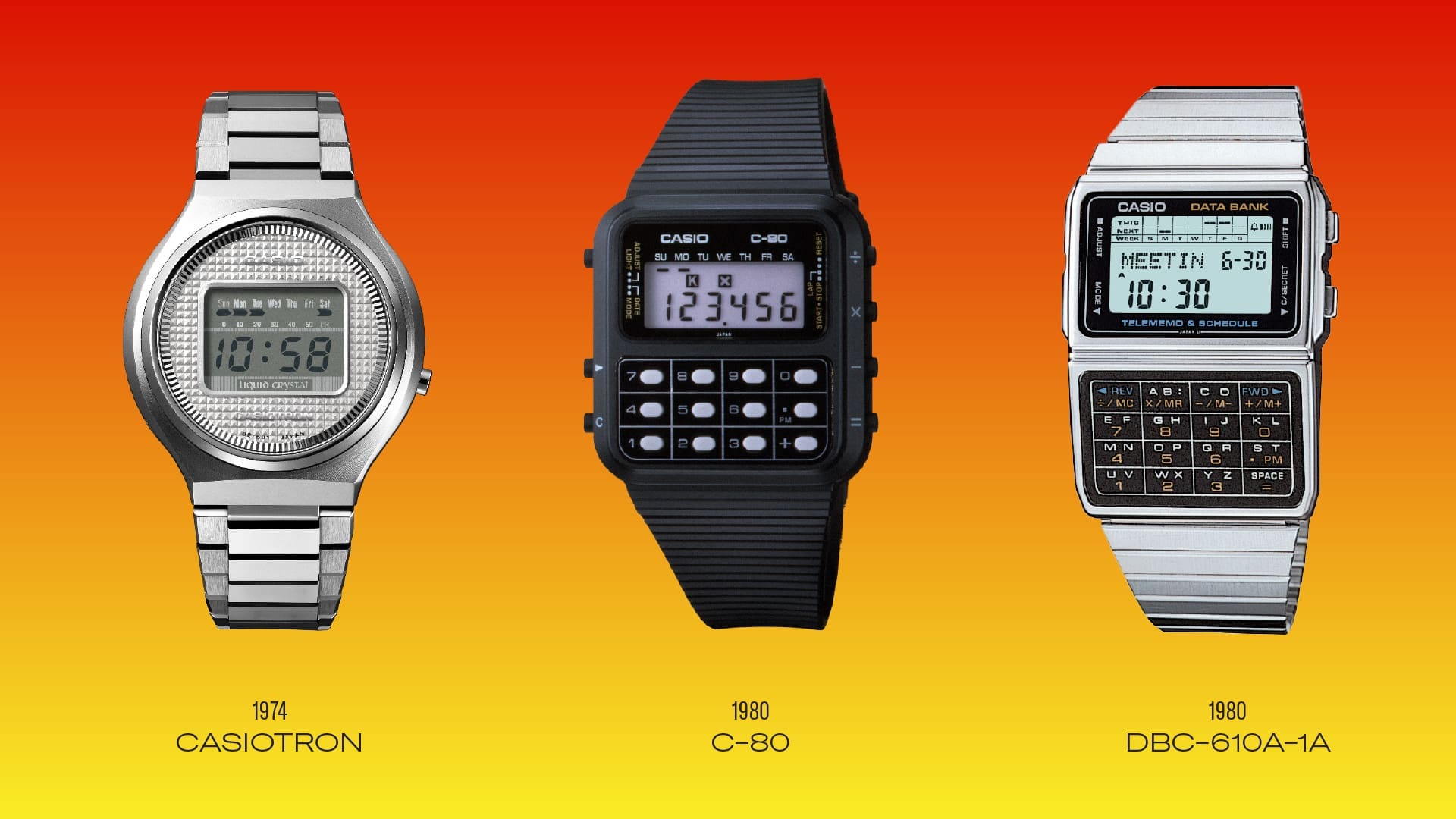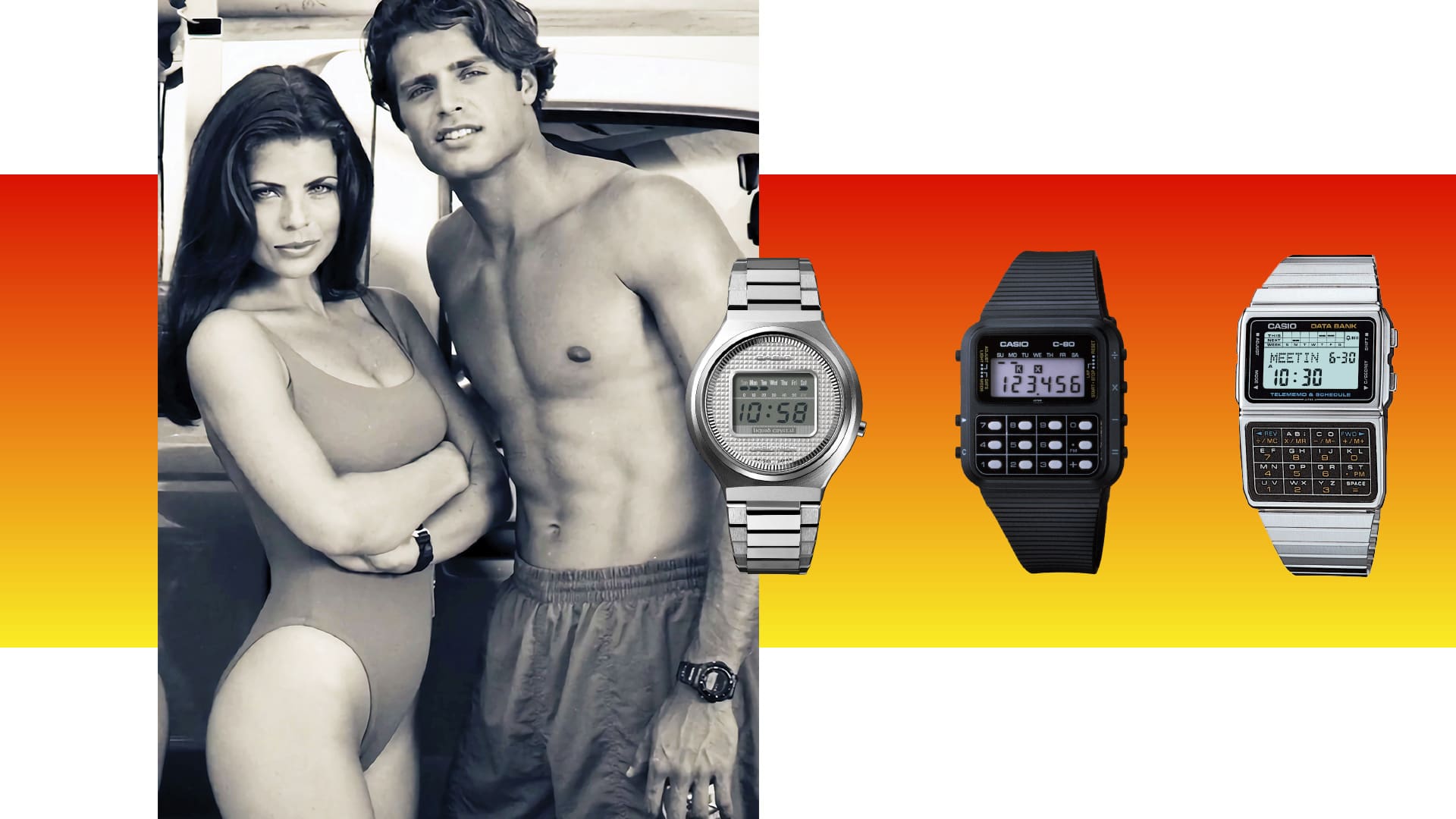The Cult of Casio: A Half-Century of Digital Cool
I have a serious addiction. It hasn’t so much cost family and friends, that I know of anyway but it has become an overly consuming pastime. And it was one night in January when I realised I reached the bottom of the barrel. In a haze of nostalgic fervour, I was freeze-framing old episodes of BayWatch to find something that had been haunting me for months. It was partway through season four, episode 22 when I finally found it. On the wrist of lifeguard, Matt Brody played by David Charvet was the unmistakable silhouette of a watch that I remembered well. It all came back to me.
I had this memory of the first watch that I wore as a kid, I knew it was a surfing timer, and I knew it had a neat wave countdown feature but beyond that, I just couldn’t recall the model. My original was long gone but for some reason, I kept thinking about this first watch. I did recall from my childhood years though that I was chuffed to know that I was in the same horological club as a Baywatch star. Our similarities diverged after that, unfortunately. Anyway, at least that important 90’s cultural icon of a TV show was able to help me find another important 90’s icon. The Casio Suf-100. The OG surfing timer. It all came flooding back. I scoured TradeMe but had to go overseas via eBay to actually find one. It turns out, I am not the only one with a tinge of nostalgia these days. Vintage Casio watches can be expensive and hard to find. Unfortunately, my nostalgia is stronger than my fiscal sense so I now have 3 Casio SUF-100s, one with a rare white dial, one all-black, and one with a splash of 90s yellow. Even this rabbit hole would have been enough, but it wasn’t. In researching the Suf-100, I came across the 90s Casio DW-403, a chunkier version of the surfing timer, which I now have as part of the collection. This also led to the MD-703 divers watch from 1989, the current Duro 200 divers watch and then for some reason leapt over to the Casio 8208 0A-53W Calculator Watch from 1988.
The thing is that as far as Casio watch collections go, I am a complete lightweight. There are many more people globally who take this far more seriously and are willing to spend eye-watering amounts. So just what is it about the vast world of Casio watches that reduces fully grown men to freeze-framing old TV shows in the hunt for that perfect watch? Well, this year Casio celebrates 50 years of making watches so it’s the perfect time to dig into the archives.
The journey began with the Casiotron, launched in 1974, which proudly introduced the world to the automatic calendar watch. This was no small feat in an era when remembering whether it was a leap year or not was considered a significant cognitive burden. The Casiotron not only displayed the time but also dutifully kept track of the date, adjusting for short months and leap years without any human intervention, a feature that undoubtedly saved relationships and prevented countless missed anniversaries.

Casio took its calculator capability and mixed it in with its watch-making division to give the world the first calculator watch in the late 1970s. The models, like the beloved C-80, turned the wrists of their wearers into miniature math labs. Casio’s calculator watches became so iconic that they made their way into pop culture lore, featuring in everything from children’s cartoons to blockbuster movies.
The 1980s witnessed Casio embracing both the ridiculous and the sublime with the introduction of the Data Bank series. These watches could store telephone numbers and other data, predating the smartphone’s contact list by several decades. The most famous among them, the DBC-610, launched in 1985, could store 50 phone numbers, making it the must-have accessory for the busy, popular professional on the go.
However, it was in 1983 that Casio changed the game with the G-Shock. Designed by an engineer who dreamt of crafting the world’s toughest watch. One that could handle a 10-metre fall, and had 10 bar water resistance and a 10 year battery life. The first model, the DW-5000C, was a chunky piece of wrist armour, resistant to shocks and water. It became the go-to watch for athletes and adventurers.
1989 saw the release of the F-91W, which would become one of the most popular and enduring digital watches ever made. This model featured a simple yet effective design, offering an alarm, stopwatch, and an hourly time signal, all housed in a slender, unassuming case. The F-91W combined functionality with a stealthy charm.
The 90s saw the continued evolution of the Data Bank series. With the 90s’ burgeoning obsession with all things digital, these watches were less about mere timekeeping and more about holding onto your personal data like techno-squirrel stashing nuts.
Meanwhile, the G-Shock series, which had already established its rugged reputation, turned up the toughness. In 1993, Casio released the DW-6300, the first G-Shock “Frogman,” designed for divers and anyone else who felt the need to submerge themselves in water under extreme conditions. This watch wasn’t just water-resistant; it was nearly invincible, resistant to the pressures both underwater and of daily life.
In 1994, Casio introduced the VDB-1000, essentially a secretary on your wrist, long before anyone thought to check their email on their phones. It could store a bewildering array of information and was perfect for the organised and the forgetful alike, able to remind you of an anniversary while calculating how much you’d spent on gifts over the years.

Towards the end of the decade, Casio turned its tech wizardry to new domains. They dabbled in digital photography, launching consumer cameras that hinted at Casio’s knack for packing advanced technology into compact forms—a philosophy that pervaded their watch design, striving to cram every conceivable feature into a space just big enough to strap around a wrist.
And in the year 2000, Casio did just that with the WQV-1, the first wristwatch with a built-in digital camera. The WQV-1 could capture images, pioneering the selfie way before smartphones made it cool—or overdone. It was perfect for those spontaneous moments when pulling out a camera (or phone) was too mainstream.
Then came the MP3 watch in 2000, the WMP-1, “a jukebox to your wrist!”. With 32 MB of storage, it promised about an hour of music playback, assuming your playlist consisted entirely of short, heavily compressed tracks. It was ideal for joggers who liked their music one album at a time and didn’t mind the occasional arm-dance to switch tracks.
In the same year came the very first Casio EDIFICE the EF-100, featuring an analogue design focused on the hour, minute, and seconds hands. The EDIFICE line has carved out a spot as the motorsport watch line thanks to the heritage of Casio electronic technologies, the stopwatch functions include millisecond accuracy, 200-lap memory, smartphone pairing for data transfer, and target time indicator.
In 2001 Casio took care of the hassle of time setting and battery replacement with the launch of the WVA-300. A solar-powered watch with radio control for precision timekeeping. Equipped with standard-time radio wave reception and Tough Solar functionality, this watch not only packed a chunk of technology it also came with a cool name. Wave Ceptor!
In 2004, Casio went deep with the OCW-500, the world’s first full-metal chronograph with solar power and radio control to launch the OCEANUS line, named for the Greek god of the sea. Incorporating materials like titanium and sapphire crystal, and with some variants finished by master craftsmen, the OCEANUS line has become a respected mark of quality.
Before biometrics was a Silicon Valley buzzword, Casio was way ahead of the curve with their 2005 launch of the CHR-100, which delivered real-time heart rate monitoring via a sensor-equipped chest strap that wirelessly transmitted heart rate data to your watch. It could display changes in heart rate or exercise intensity numerically or on graphs, allowing you to monitor or even gamify your workouts.
And while Casio was helping fitness buffs plot their performance they weren’t going to drop the medicine ball on craftsmanship and finish. In 2012 Yamagata Casio Premium Production Line reached full operation. This ramped up Casio’s precision engineering and craftsman capabilities for the likes of OCEANUS and MR-G lines.

In 2014, Casio put global navigation on your wrists with the GPW-1000, a GPS hybrid radio-controlled, solar-powered watch. Now, not only could your watch tell you the time but also exactly where you were on the planet.
In 2016, Casio jumped into the smartwatch party with the release of the WSD-F10 Smart Outdoor Watch, equipped with Android Wear (now Wear OS). This rugged smartwatch was designed for the outdoor enthusiast who didn’t want to sacrifice connectivity for durability. It featured water resistance, military-standard compliance, and a plethora of sensors to track everything from hiking trails to fish you almost caught.
In 2017, to prove the legendary toughness of their G-SHOCK line, a DW-5600E-1 model was driven over by a 24.97-ton truck, earning the Guinness World Record for the heaviest vehicle to drive over a watch. It survived unscathed because, of course, it was a G-SHOCK.
Casio continued to innovate with a focus on health and fitness and the GBD-H1000 was introduced in 2020, combining G-SHOCK resilience with an optical heart rate sensor, GPS functionality, and solar charging. This watch was for the fitness buffs who liked their workouts quantified and their watches indestructible.
Entering 2023, Casio once again showed its dedication to innovation with the launch of the G-SHOCK MOVE line. These watches not only kept track of your every step and heartbeat but did so with style and the typical G-SHOCK robustness, proving that even in a digital age, some physical constants—like the reliability of a good watch—remained unshakeable.
Like all good watch stories, Casio is taking the journey full circle back to 1974 — with the release of the TRN-50, a limited edition re-creation of the original Casiotron. This isn’t just a nostalgia trip though; consider it a victory lap for a watch that knew the month had changed before you did.
Limited to a run of 4,000 pieces, the TRN-50 is designed to mirror the original, complete with a dark blue dial and that vintage Casiotron logo, but with a few new tricks that it has picked up over the decades. It syncs with a smartphone and has time calibration from signals beamed from six stations around the world.
The TRN-50 is a celebration of how far we’ve come since the days when having a calculator on your wrist made you the coolest kid in class (I went to a very simple school). It’s a tribute to Casio’s enduring spirit of innovation.

